Monday, December 27, 2010
Shameless Plug
From Dave Brigham:
We interrupt this blog about dilapidated buildings, abandoned vehicles and old quarries to bring you a bit of shameless self-promotion. I've published my first book, a collection of short stories called (C)rock Stories: Million-Dollar Tales of Music, Mayhem and Immaturity.
You can buy it here.
We now return you to your regularly scheduled blog.
We interrupt this blog about dilapidated buildings, abandoned vehicles and old quarries to bring you a bit of shameless self-promotion. I've published my first book, a collection of short stories called (C)rock Stories: Million-Dollar Tales of Music, Mayhem and Immaturity.
You can buy it here.
We now return you to your regularly scheduled blog.
Sunday, December 26, 2010
Where the Sun Never Sets
From Dave Brigham:
The sun never sets in Auburndale, Mass.
I pass by this mural to and from my daughter's preschool three days a week. Tens of thousands pass it every day on the Mass. Pike. Most people, if they notice it at all, have no idea the history behind it. I didn't either until I hit the "return" button on my Google search. Even still, I have more questions than answers.
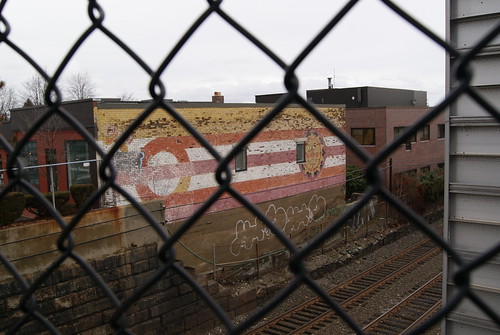
According to a blog thread at the web site for the Newton Tab weekly newspaper, the mural was painted in 1969 or 1970 on the back of a "new-Agey" store called "Ends of the Earth." Evidently, according to the blog, the mural attracted local and national press because of the "hidden meaning" the painting held. Two people posted on the blog about this supposed meaning, which may or may not have been obscene, but nobody has any details.
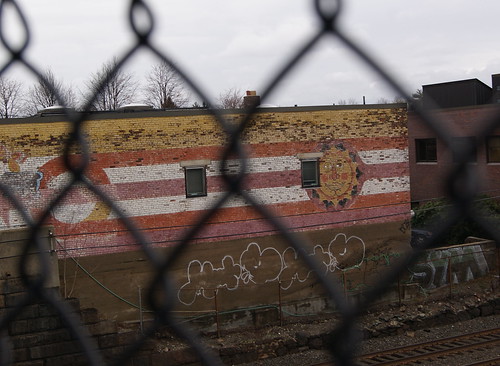
Nowadays, it seems very innocent: a sun, what appears to be a butterfly, a circle and some long, straight lines. I'd really like to know what was on the mural in its original incarnation. I may have to buy a time machine, which would be worth it, because according to another post on the above-mentioned blog, the building used to be a restaurant and bar.
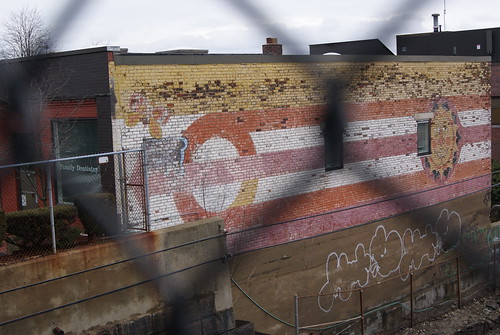
Who painted this mural? What was on it that some people deemed obscene? What products did "Ends of the Earth" sell? Why did this mural get saved in a cleaned-up version? So many questions...
The sun never sets in Auburndale, Mass.
I pass by this mural to and from my daughter's preschool three days a week. Tens of thousands pass it every day on the Mass. Pike. Most people, if they notice it at all, have no idea the history behind it. I didn't either until I hit the "return" button on my Google search. Even still, I have more questions than answers.

According to a blog thread at the web site for the Newton Tab weekly newspaper, the mural was painted in 1969 or 1970 on the back of a "new-Agey" store called "Ends of the Earth." Evidently, according to the blog, the mural attracted local and national press because of the "hidden meaning" the painting held. Two people posted on the blog about this supposed meaning, which may or may not have been obscene, but nobody has any details.

Nowadays, it seems very innocent: a sun, what appears to be a butterfly, a circle and some long, straight lines. I'd really like to know what was on the mural in its original incarnation. I may have to buy a time machine, which would be worth it, because according to another post on the above-mentioned blog, the building used to be a restaurant and bar.

Who painted this mural? What was on it that some people deemed obscene? What products did "Ends of the Earth" sell? Why did this mural get saved in a cleaned-up version? So many questions...
Tuesday, December 21, 2010
Breakdown, Go Ahead and Give It To Me
Backside contributor Joe Viger recently hipped Backside management about photographer Christina Tullo's excellent web site. Designedbreakdown "is an all-encompassing collection of her photography focusing mainly on the breakdown of society's architectual progress when ravaged by time and neglect," according to Ms. Tullo.
Athletic fields, industrial ruins, decrepit hospitals, eerie seascapes, churches -- Tullo's images of these places are amazing, beautiful, sad, haunting, breathtaking and more.
Athletic fields, industrial ruins, decrepit hospitals, eerie seascapes, churches -- Tullo's images of these places are amazing, beautiful, sad, haunting, breathtaking and more.
Thursday, December 16, 2010
Granite Foundations on the Backside of Walmart
From Joe Viger:
My local Walmart is store #2140 in North Conway, NH. It was built on a tract of land near the southern end of Rattlesnake Mountain and the Nature Conservancy's Green Hills Preserve. Look up over the store at the slopes of Rattlesnake Mountain and you might notice that the granite cliffs seem too square to be natural. Ignore your shopping and take a 15 minute walk and you'll discover that what you were looking at from down in the Walmart parking lot are the remnants of two granite quarries over 100 years old.

In the 1800's the area had already been a source of granite boulders for bridges and foundations. In 1880, a roadmaster for the Maine Central Railraod named George Wagg brought samples of the stone to the Maine Central President, Payson Tucker, and J.H. Emery of the North Jay Granite Company. Land on Rattlesnake Mountain was acquired and by 1887 Wagg was president of the Maine and New Hampshire Granite Company and Redstone Quarry took shape. The site was expanded with additional land purchases, a cutting yard at the base of the mountain and a branch line from the Maine Central.


The quarry was valuable for producing two colors of granite... pink and green. At the height of production, Redstone was a vital community of 350 stone workers and tradesmen with its own train station and company-owned housing. The quarries supported 10 derricks moving stone down the slope. Stone lathes produced turned granite columns and skilled carvers created statue pieces. Green granite from Redstone was used to build the Hatch Shell in Boston. Pink granite made its way to New York for Grant's Tomb and Washington in the National Archives building.




The history of this site is well described in an article called "Redstone Granite Quarries" at WhiteMountainHistory.org and I'm thankful to cite it as a source for the text above, along with Wikipedia. Early photographs can been seen here.
My local Walmart is store #2140 in North Conway, NH. It was built on a tract of land near the southern end of Rattlesnake Mountain and the Nature Conservancy's Green Hills Preserve. Look up over the store at the slopes of Rattlesnake Mountain and you might notice that the granite cliffs seem too square to be natural. Ignore your shopping and take a 15 minute walk and you'll discover that what you were looking at from down in the Walmart parking lot are the remnants of two granite quarries over 100 years old.

In the 1800's the area had already been a source of granite boulders for bridges and foundations. In 1880, a roadmaster for the Maine Central Railraod named George Wagg brought samples of the stone to the Maine Central President, Payson Tucker, and J.H. Emery of the North Jay Granite Company. Land on Rattlesnake Mountain was acquired and by 1887 Wagg was president of the Maine and New Hampshire Granite Company and Redstone Quarry took shape. The site was expanded with additional land purchases, a cutting yard at the base of the mountain and a branch line from the Maine Central.


The quarry was valuable for producing two colors of granite... pink and green. At the height of production, Redstone was a vital community of 350 stone workers and tradesmen with its own train station and company-owned housing. The quarries supported 10 derricks moving stone down the slope. Stone lathes produced turned granite columns and skilled carvers created statue pieces. Green granite from Redstone was used to build the Hatch Shell in Boston. Pink granite made its way to New York for Grant's Tomb and Washington in the National Archives building.




The history of this site is well described in an article called "Redstone Granite Quarries" at WhiteMountainHistory.org and I'm thankful to cite it as a source for the text above, along with Wikipedia. Early photographs can been seen here.
Wednesday, December 8, 2010
Ridin' the Rails on a Small Scale
From Dave Brigham:
I find enjoyment on many levels from riding the Boston subway system with my son, who's eight. I like spending four hours or so, just the two of us, checking out the Blue, Orange, Red, and Green lines; trying to solve the mystery of just where do those doors in the tunnels lead to; taking pictures of graffiti; people watching; eating lunch at South Station -- always Regina Pizzeria despite the plethora of options. I also take pleasure from the occasional Amtrak trip from Boston to New York, riding along the Connecticut shore, checking out the lesser-seen elements of cities like Providence, New London and Bridgeport, as well as small towns all along the way.
So imagine my excitement to learn about railcar trips in a recent Boston Globe article. Also called motorcars, these little vehicles are like bread boxes on wheels that railroad inspectors and maintenance workers used before the advent of regular trucks fitted with retractable guide wheels that ride the rails. Long story short: railroad enthusiasts buy and maintain these vehicles, form clubs and negotiate with railroads for time on the tracks.
Here's the Globe article, which includes a short video.
I find enjoyment on many levels from riding the Boston subway system with my son, who's eight. I like spending four hours or so, just the two of us, checking out the Blue, Orange, Red, and Green lines; trying to solve the mystery of just where do those doors in the tunnels lead to; taking pictures of graffiti; people watching; eating lunch at South Station -- always Regina Pizzeria despite the plethora of options. I also take pleasure from the occasional Amtrak trip from Boston to New York, riding along the Connecticut shore, checking out the lesser-seen elements of cities like Providence, New London and Bridgeport, as well as small towns all along the way.
So imagine my excitement to learn about railcar trips in a recent Boston Globe article. Also called motorcars, these little vehicles are like bread boxes on wheels that railroad inspectors and maintenance workers used before the advent of regular trucks fitted with retractable guide wheels that ride the rails. Long story short: railroad enthusiasts buy and maintain these vehicles, form clubs and negotiate with railroads for time on the tracks.
Here's the Globe article, which includes a short video.
And here's a gallery from an enthusiast web site featuring some great pictures of the cars, as well as cool scenery along a trip in Georgia.
Wednesday, December 1, 2010
Abandon Us...But Please Come Back!
The Boston Globe recently published a profile of "urban ruins photographer" Jason Baker, who just published his third book, "Abandoned 2," which features five short horror stories (written by others) accompanied by Baker's pictures of abandoned state hospitals.
You can see the pictures that accompanied the Globe story here and check out other Baker works here.
You can see the pictures that accompanied the Globe story here and check out other Baker works here.
Don't forget to come back to the Backside. Upcoming features will cover the eyesore hole in the ground in Boston's Downtown Crossing where Filene's used to be; the part of old Route 128 that runs in the Blue Hills Reservation outside Boston; old granite quarries behind the Walmart in North Conway, NH; and the first pictures from new contributor Michael Cevoli, which I'm excited to post.
Wednesday, November 24, 2010
Facing Death
From Dave Brigham:
I've lived in the Boston area for 20 years, roughly the amount of time since the Faces nightclub on Route 2 in Cambridge closed down. Oddly, pinning down just how long the place has been shuttered is difficult, even for Cambridge government officials. You'd think in this day and age it wouldn't be that hard to figure how long one of the most infamous eyesores in the city has been messing up the view as folks enter Cambridge from the west.

A year ago, the Cambridge Day newspaper reported that the Faces site was getting cleaned up, quoting representatives for the property owners indicating that "there is a plan" for the site. The property is no longer zoned for entertainment, but rather for office space, R&D and housing. As you can see, not much has happened since that promise.
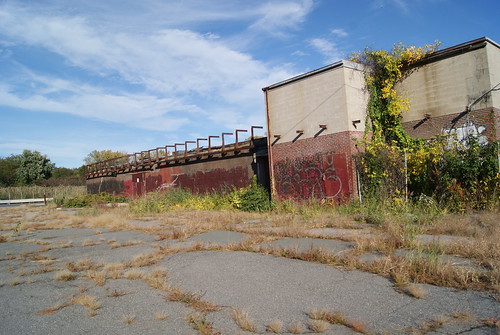
I snapped these photos while at the Lanes & Games bowling alley next door with my wife and kids. Even if I'd been alone, however, I wouldn't have been able to venture inside, as you can see.
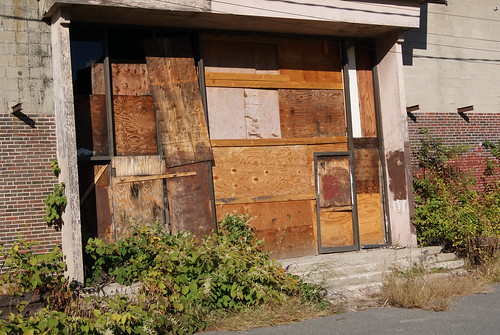
Here are some great shots from somebody who did venture inside.
I've lived in the Boston area for 20 years, roughly the amount of time since the Faces nightclub on Route 2 in Cambridge closed down. Oddly, pinning down just how long the place has been shuttered is difficult, even for Cambridge government officials. You'd think in this day and age it wouldn't be that hard to figure how long one of the most infamous eyesores in the city has been messing up the view as folks enter Cambridge from the west.

A year ago, the Cambridge Day newspaper reported that the Faces site was getting cleaned up, quoting representatives for the property owners indicating that "there is a plan" for the site. The property is no longer zoned for entertainment, but rather for office space, R&D and housing. As you can see, not much has happened since that promise.

I snapped these photos while at the Lanes & Games bowling alley next door with my wife and kids. Even if I'd been alone, however, I wouldn't have been able to venture inside, as you can see.

Here are some great shots from somebody who did venture inside.
Thursday, November 18, 2010
Guido's Court
From Dave Brigham:
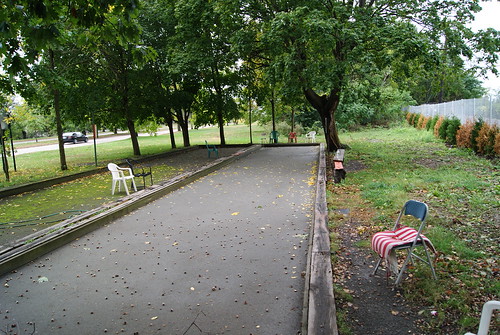
I wanted to get to this bocce court when some of the old-timers were actually playing, but by the time I fit my trip in, their season was over. I've lived in the Boston area for 20 years, and had driven by this location many times but only in the last few years did I discover it was home to a bocce court.
The court is on the Leo J. Birmingham Parkway, a short stretch of road that runs parallel to the Mass. Pike, up a hill from Staples and Martignetti Liquors in Brighton, and just around the corner from the old Charles River Speedway headquarters (see 9-6-10 UPDATED: Horsing Around at the Old Barracks). A Google search turned up the fact that the Mass. Legislature officially named the court in Guido Salvucci's honor in September 2003, but Google didn't provide any clues as to the honored man's identity.
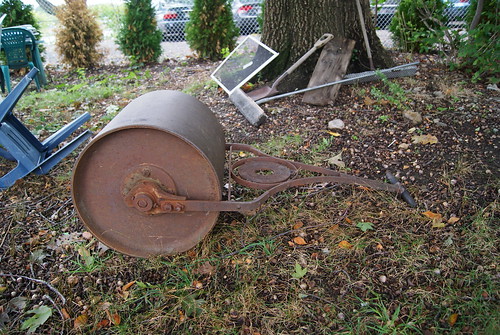
I love the simplicity of this site, and the old-fashioned tools and scoreboards. Seems like a great place to hang out on a lazy summer afternoon, drink some grappa and get a few lessons, if you're so inclined.


I wanted to get to this bocce court when some of the old-timers were actually playing, but by the time I fit my trip in, their season was over. I've lived in the Boston area for 20 years, and had driven by this location many times but only in the last few years did I discover it was home to a bocce court.
The court is on the Leo J. Birmingham Parkway, a short stretch of road that runs parallel to the Mass. Pike, up a hill from Staples and Martignetti Liquors in Brighton, and just around the corner from the old Charles River Speedway headquarters (see 9-6-10 UPDATED: Horsing Around at the Old Barracks). A Google search turned up the fact that the Mass. Legislature officially named the court in Guido Salvucci's honor in September 2003, but Google didn't provide any clues as to the honored man's identity.

I love the simplicity of this site, and the old-fashioned tools and scoreboards. Seems like a great place to hang out on a lazy summer afternoon, drink some grappa and get a few lessons, if you're so inclined.

Friday, November 12, 2010
Mining for the Backside
From Mick Melvin:
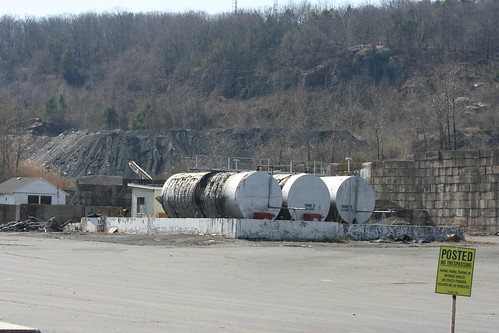
I went out to shoot a few backside pictures and saw this building with a big government sign posted. I almost didn't stop for fear of being whisked away by the “men in black.” I've always been curious about this site along Route 6 in Farmington, CT. I ended up looking closely at the sign that read, "U.S. Government M.S.H.A. Registered Mine."

"Tilcon Connecticut" was also printed in small red letters at the bottom of the sign.
As I often do, I went home to do some research on the location. I ended up finding the Tilcon Connecticut web site. Tilcon Connecticut deals in crushed stone, hot mix asphalt and ready mix concrete. There are over 20 sites throughout CT that sell any combination of the three. The site along Route 6 in Farmington doesn't seem to be producing much these days except some shots for the Backside.


I went out to shoot a few backside pictures and saw this building with a big government sign posted. I almost didn't stop for fear of being whisked away by the “men in black.” I've always been curious about this site along Route 6 in Farmington, CT. I ended up looking closely at the sign that read, "U.S. Government M.S.H.A. Registered Mine."

"Tilcon Connecticut" was also printed in small red letters at the bottom of the sign.
As I often do, I went home to do some research on the location. I ended up finding the Tilcon Connecticut web site. Tilcon Connecticut deals in crushed stone, hot mix asphalt and ready mix concrete. There are over 20 sites throughout CT that sell any combination of the three. The site along Route 6 in Farmington doesn't seem to be producing much these days except some shots for the Backside.

Thursday, November 4, 2010
Can You Ever Get Enough of Train Tracks?
As any hobo knows, some of the best views of any town or city are from a train. Here are some shots of train tracks, subway systems and affiliated locales and items from a few of Backside's contributors.
Iron pin in retaining wall for abandoned B&M trestle, Waltham, MA
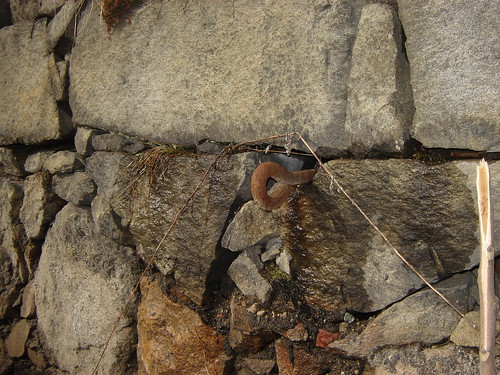
(Photo by Dave Brigham)
Tracks in Bristol, CT
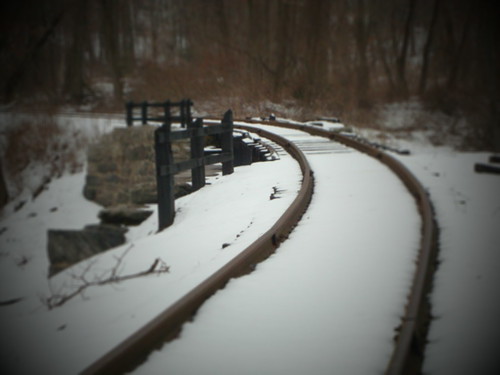
(Photo by David Burke)
Tracks at old train station in Torrington, CT

(Photo by Michelle Loya)
Tracks over a stream, Torrington, CT
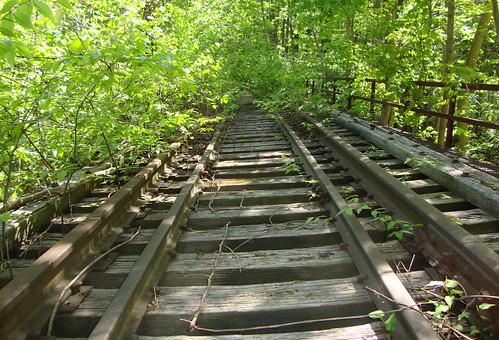
(Photo by David Burke)
Decrepit train in Essex, CT
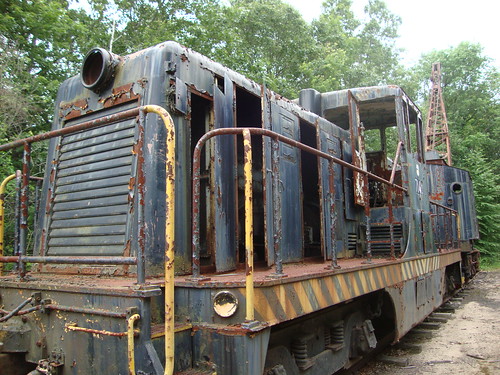
(Photo by David Burke)
Trackside mail box at JFK/UMass stop on Boston's Red Line
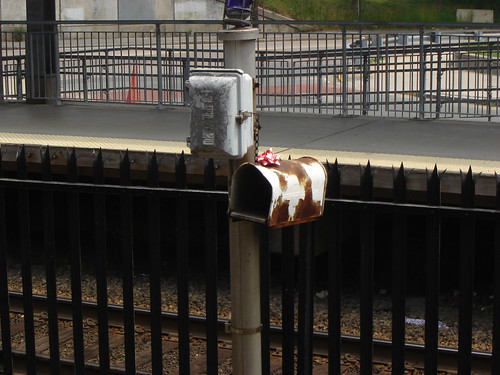
(Photo by Dave Brigham)
End of Red Line, Ashmont Station, Boston, MA

(Photo by Dave Brigham)
Iron pin in retaining wall for abandoned B&M trestle, Waltham, MA

(Photo by Dave Brigham)
Tracks in Bristol, CT

(Photo by David Burke)
Tracks at old train station in Torrington, CT

(Photo by Michelle Loya)
Tracks over a stream, Torrington, CT

(Photo by David Burke)
Decrepit train in Essex, CT

(Photo by David Burke)
Trackside mail box at JFK/UMass stop on Boston's Red Line

(Photo by Dave Brigham)
End of Red Line, Ashmont Station, Boston, MA

(Photo by Dave Brigham)
Thursday, October 28, 2010
UPDATE: Butt Ugly Building
From Dave Brigham:
Thanks to my buddy Gary Holmes for letting us know that demolition began yesterday on Hartford's Butt Ugly Building (see 8-15-10 "The Butt Ugly Building").
This article in the Hartford Courant indicates that the tear-down should be complete by mid-November, and that the city, which acquired the building earlier this year, is soliciting developers from across the country in hopes of building a multi-use development.
Thanks to my buddy Gary Holmes for letting us know that demolition began yesterday on Hartford's Butt Ugly Building (see 8-15-10 "The Butt Ugly Building").
This article in the Hartford Courant indicates that the tear-down should be complete by mid-November, and that the city, which acquired the building earlier this year, is soliciting developers from across the country in hopes of building a multi-use development.
Wednesday, October 27, 2010
Off the Air
From Mick Melvin:
When I was kid, my father told me that when he moved to a new area he would take a ride and get lost. He said he would familiarize himself with the area that way. I was out for one of my weekend “Backside” rides in CT and had gotten lost. Thinking of my dad, I just took in the sights and familiarized myself with the area. In doing so, I came upon a Backside gem.
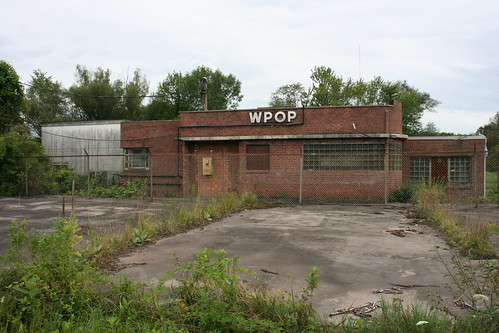
As I drove along Route 173 in Newington, I saw a building with the call letters of a radio station, WPOP. Not being from CT, I was not aware of this station. I asked my wife, who is from West Hartford, about WPOP and she said she listened to the station when she was young. She said right away, “WPOP Good Guys,” recalling a time in the '60's and '70's when the station's DJs were called the Good Guys. The station played Top 40 music at the time. The station was sold to Merv Griffin in the early '70's and soon became an NBC news and information station. The radio station left the Newington location in 1998, leaving the space abandoned like many of our backside subjects.
When I was kid, my father told me that when he moved to a new area he would take a ride and get lost. He said he would familiarize himself with the area that way. I was out for one of my weekend “Backside” rides in CT and had gotten lost. Thinking of my dad, I just took in the sights and familiarized myself with the area. In doing so, I came upon a Backside gem.

As I drove along Route 173 in Newington, I saw a building with the call letters of a radio station, WPOP. Not being from CT, I was not aware of this station. I asked my wife, who is from West Hartford, about WPOP and she said she listened to the station when she was young. She said right away, “WPOP Good Guys,” recalling a time in the '60's and '70's when the station's DJs were called the Good Guys. The station played Top 40 music at the time. The station was sold to Merv Griffin in the early '70's and soon became an NBC news and information station. The radio station left the Newington location in 1998, leaving the space abandoned like many of our backside subjects.
Thursday, October 21, 2010
These Boots Were Made for Explorin'
From Dave Brigham:
Because their sensibility about America's rump is right in line with The Backside, the folks at Palladium Boots have almost convinced me to buy some quality French footwear. Recently, I highlighted the documentary about Detroit that the company made with Johnny Knoxville of "Jackass" fame (see October 10, 2010: Reppin' for the Motor City). Today I'm pimpin' three more of the company's short films about hidden and dilapidated parts of the country, as well as one coal mine that's been burning since 1962.
In the first doc, a pleasant young woman and her crew go in search of abandoned missile silos in Washington and Kansas that have been left for graffiti artists, amateur spelunkers, UFO researchers, and real estate prospectors, among others. Stick around 'til the end for a tour of a silo property that's been converted into a hippy haven.
In the second film, a pleasant young man takes a tour of a slew of New York City's ruins, including a power station in Yonkers, a subway tunnel in Harlem, and a grain terminal in Brooklyn.
In the third documentary, another fine, upstanding young man tours Centralia, PA, home to a labyrinth of coal mines that caught fire in 1962, and is still burning.
Because their sensibility about America's rump is right in line with The Backside, the folks at Palladium Boots have almost convinced me to buy some quality French footwear. Recently, I highlighted the documentary about Detroit that the company made with Johnny Knoxville of "Jackass" fame (see October 10, 2010: Reppin' for the Motor City). Today I'm pimpin' three more of the company's short films about hidden and dilapidated parts of the country, as well as one coal mine that's been burning since 1962.
In the first doc, a pleasant young woman and her crew go in search of abandoned missile silos in Washington and Kansas that have been left for graffiti artists, amateur spelunkers, UFO researchers, and real estate prospectors, among others. Stick around 'til the end for a tour of a silo property that's been converted into a hippy haven.
In the second film, a pleasant young man takes a tour of a slew of New York City's ruins, including a power station in Yonkers, a subway tunnel in Harlem, and a grain terminal in Brooklyn.
In the third documentary, another fine, upstanding young man tours Centralia, PA, home to a labyrinth of coal mines that caught fire in 1962, and is still burning.
Saturday, October 16, 2010
Faded Glory
From Dave Brigham:
I recently took my daughter, Amelia, to the Joanne C. Pellegrini playground in Newton, just a few minutes from where we live. I hadn't been there in years, and had forgotten about the three huge murals on the walls of the small community center, and a retaining wall at the back of the property.
The park is named for the late wife of the late Anthony "Fat" Pellegrini, the colorful, unofficial (mobbed up?) mayor of Newton's Nonantum section. Known to locals as The Lake, Nonantum was for years the Italian section of town, and still is to some degree. Fat's son, an Elvis impersonator who went by the name Monk Pelli, used to perform regularly at this park, right in front of the mural of The King.
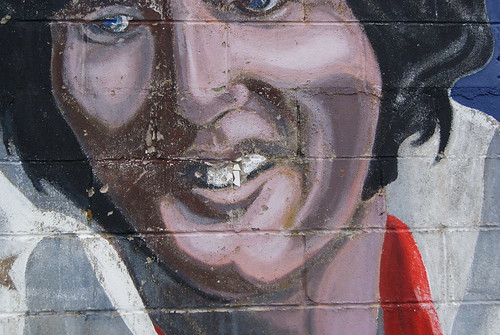
I never saw Pelli perform; I went to the park once with my girlfriend (now wife) and a few friends hoping to see the show, but it got delayed so long that we bagged it. Lifelong regret, that one.
The detail from mural below shows the Marx Brothers. Other characters on the wall include Mickey and Minnie Mouse, Charlie Chan, Laurel and Hardy and Charlie Brown. My wife, who grew up in Newton and knows The Lake well, claims Fat is depicted on the mural as well, but I couldn't pick him out.

The most prominent mural, and best preserved, is the one of the late Arthur Fiedler conducting the Boston Pops for their world renowned Fourth of July concert in Boston.
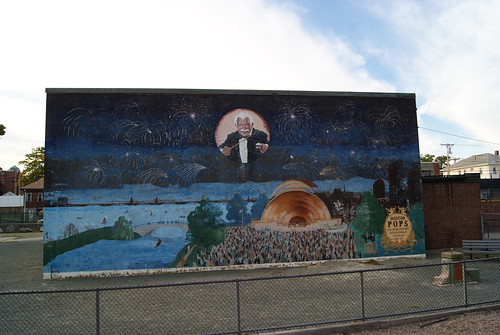
I recently took my daughter, Amelia, to the Joanne C. Pellegrini playground in Newton, just a few minutes from where we live. I hadn't been there in years, and had forgotten about the three huge murals on the walls of the small community center, and a retaining wall at the back of the property.
The park is named for the late wife of the late Anthony "Fat" Pellegrini, the colorful, unofficial (mobbed up?) mayor of Newton's Nonantum section. Known to locals as The Lake, Nonantum was for years the Italian section of town, and still is to some degree. Fat's son, an Elvis impersonator who went by the name Monk Pelli, used to perform regularly at this park, right in front of the mural of The King.

I never saw Pelli perform; I went to the park once with my girlfriend (now wife) and a few friends hoping to see the show, but it got delayed so long that we bagged it. Lifelong regret, that one.
The detail from mural below shows the Marx Brothers. Other characters on the wall include Mickey and Minnie Mouse, Charlie Chan, Laurel and Hardy and Charlie Brown. My wife, who grew up in Newton and knows The Lake well, claims Fat is depicted on the mural as well, but I couldn't pick him out.

The most prominent mural, and best preserved, is the one of the late Arthur Fiedler conducting the Boston Pops for their world renowned Fourth of July concert in Boston.

Sunday, October 10, 2010
Reppin' for the Motor City
From Dave Brigham:
Thanks to my father-in-law, Rich, for tipping me off to this David Byrne article about the long decline of Detroit. Musician, writer, actor, artist, advocate for world music and former leader of Talking Heads, Byrne gives a great sense of why the Motor City is in the dire straits that it's in today: domination by the auto industry shut out any public transportation presence; white flight, as in many other big cities in the 1960's, following fierce riots; the financial meltdown that has hit few cities as hard. It's a great read and features some cool photos and Byrne's hope that "if the city center here can become more of the focus then a much smaller town with vibrant life might emerge."
While Byrne focuses largely on the problems besetting Motown, actor/professional jackass Johnny Knoxville has teamed with Palladium Boots to produce "Detroit Lives," a 30-minute documentary highlighting what's right with the city.
The first part, through film-strip footage and talking head commentary, provides a quick story of the rise and fall of the city. Then, local artists, activists, restaurateurs and musicians step up to talk about opportunity for creativity and commerce:
In the second part, Knoxville tours the city with two members of longtime local band The Dirtbombs, talks with MC5 guitarist Wayne Kramer, tromps through a dilapidated movie and music theater, and even strolls through Berry Gordy's former mansion:
In the third and final part, Knoxville and guests in his beautiful old Cadillac convertible discuss urban farming, explore an old Cadillac factory, hang out in an old industrial building that's been converted to artist lofts, and learn about Detroit's DIY ethic. Stick around 'til the end to see the Heidelberg Project:
Thanks to my father-in-law, Rich, for tipping me off to this David Byrne article about the long decline of Detroit. Musician, writer, actor, artist, advocate for world music and former leader of Talking Heads, Byrne gives a great sense of why the Motor City is in the dire straits that it's in today: domination by the auto industry shut out any public transportation presence; white flight, as in many other big cities in the 1960's, following fierce riots; the financial meltdown that has hit few cities as hard. It's a great read and features some cool photos and Byrne's hope that "if the city center here can become more of the focus then a much smaller town with vibrant life might emerge."
While Byrne focuses largely on the problems besetting Motown, actor/professional jackass Johnny Knoxville has teamed with Palladium Boots to produce "Detroit Lives," a 30-minute documentary highlighting what's right with the city.
The first part, through film-strip footage and talking head commentary, provides a quick story of the rise and fall of the city. Then, local artists, activists, restaurateurs and musicians step up to talk about opportunity for creativity and commerce:
In the second part, Knoxville tours the city with two members of longtime local band The Dirtbombs, talks with MC5 guitarist Wayne Kramer, tromps through a dilapidated movie and music theater, and even strolls through Berry Gordy's former mansion:
In the third and final part, Knoxville and guests in his beautiful old Cadillac convertible discuss urban farming, explore an old Cadillac factory, hang out in an old industrial building that's been converted to artist lofts, and learn about Detroit's DIY ethic. Stick around 'til the end to see the Heidelberg Project:
Monday, October 4, 2010
Abstractside
From Chris St. Cyr:
One of the aspects of Florida living that I really enjoy is the architecture -- the modern architecture, to be specific. And by modern I don’t mean the latest gated-community McMansion development next to the strip mall. I mean modern as in 20th-century. The kind of architecture that is geometric and clean with open spaces and lots of glass. The kinds of surfaces that are flat and minimal and have no need for decoration to stand out in the neighborhood.
When I moved here a few years ago I rented office space in downtown Sarasota for my graphic design firm. As I became familiar with the side streets and back alleys I began to notice a fascinating artifact that was the merging of this modern architecture and street culture. Or should I say modern art and street art.
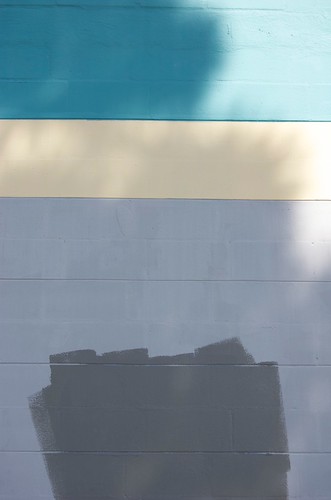
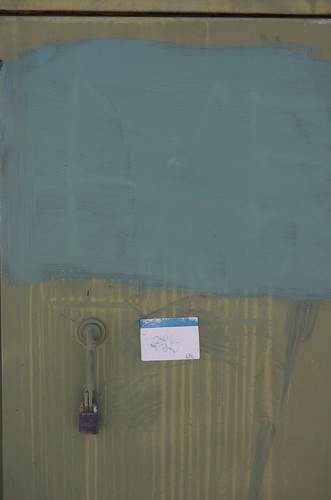
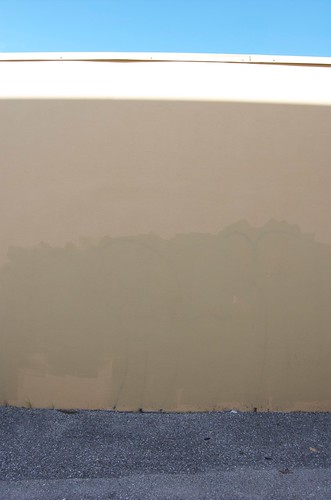
To some people the modern architecture was a beautiful clean canvas on which to create art -- in this case graffiti art. The reaction to this type of public art is of course to cover it up by painting over it. The resulting images you see here are these amazing paintings of bands of color that are reminiscent of Mark Rothko’s abstract expressionist paintings from the 1940’s and 50’s.
It’s this unintentional art that makes the backside of America so beautiful.
One of the aspects of Florida living that I really enjoy is the architecture -- the modern architecture, to be specific. And by modern I don’t mean the latest gated-community McMansion development next to the strip mall. I mean modern as in 20th-century. The kind of architecture that is geometric and clean with open spaces and lots of glass. The kinds of surfaces that are flat and minimal and have no need for decoration to stand out in the neighborhood.
When I moved here a few years ago I rented office space in downtown Sarasota for my graphic design firm. As I became familiar with the side streets and back alleys I began to notice a fascinating artifact that was the merging of this modern architecture and street culture. Or should I say modern art and street art.



To some people the modern architecture was a beautiful clean canvas on which to create art -- in this case graffiti art. The reaction to this type of public art is of course to cover it up by painting over it. The resulting images you see here are these amazing paintings of bands of color that are reminiscent of Mark Rothko’s abstract expressionist paintings from the 1940’s and 50’s.
It’s this unintentional art that makes the backside of America so beautiful.
Tuesday, September 28, 2010
Down the Drain
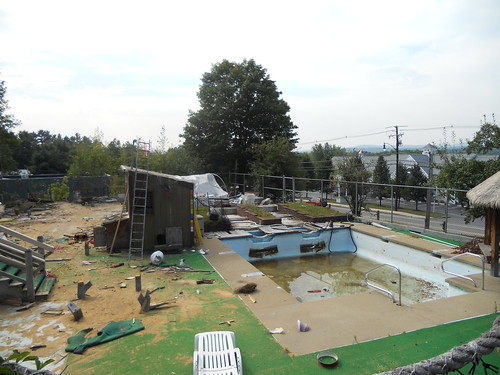
From Dave Brigham:
The demise of the Banana Village water slide in North Conway, NH, is partly my family's fault. When we visited that tourist town in the summer of 2009 we played mini golf at the village, as well as at one other place. We didn't use the water slide, but it looked like a great time. This year, however, when we made our northern pilgrimage to Story Land , we stayed at the Red Jacket Resort in North Conway, which has its own indoor water park, Kahuna Laguna. We availed ourselves of the park for the three days we were there, and had a great time.
But when we hit Banana Village for mini golf on the way out of town, we saw that it obviously couldn't compete with Kahuna Laguna, and had dismantled its water slide (although it's still featured on the web site). I don't feel too bad about the slide's swirl down the drain. I'm sure the owners will come up with some other trap to ensnare tourists and their money.
Friday, September 24, 2010
Charles River Speedway Update
From Dave Brigham:
For 20 years I lived in and around Boston, and had no idea what the long-abandoned buildings at the corner of Western Ave. and Soldiers Field Road in Brighton were. Long story short: I took some pictures, posted them on Flickr, and through a fellow user of the photo-sharing web site, learned that the buildings were once part of a horse track called the Charles River Speedway (see UPDATED: Horsing Around at the Old Barracks from Sept. 6, 2010).
In July the buildings were added to the National Register of Historic Places, which unfortunately affords the complex no protection. The Boston Globe ran an article yesterday about the century-old site, detailing how Preservation Massachusetts has added the former speedway headquarters to its Most Endangered Historic Resources list. The listing is part of the group's effort to pressure the buildings' owner, the state Department of Recreation and Conservation, to preserve the site and find alternative uses for it.
The state recently committed $132,000 to shore up foundations, replace rotted sills and restore exterior walls, according to the Globe, but all involved agree much more is needed. State lawmakers recently passed legislation to renovate the buildings and move the nearby State Police barracks there, but the current economic climate means that's not going to happen any time soon.
Here's hoping the renovations get funded, one way or another, and this site sees new life.
For 20 years I lived in and around Boston, and had no idea what the long-abandoned buildings at the corner of Western Ave. and Soldiers Field Road in Brighton were. Long story short: I took some pictures, posted them on Flickr, and through a fellow user of the photo-sharing web site, learned that the buildings were once part of a horse track called the Charles River Speedway (see UPDATED: Horsing Around at the Old Barracks from Sept. 6, 2010).
In July the buildings were added to the National Register of Historic Places, which unfortunately affords the complex no protection. The Boston Globe ran an article yesterday about the century-old site, detailing how Preservation Massachusetts has added the former speedway headquarters to its Most Endangered Historic Resources list. The listing is part of the group's effort to pressure the buildings' owner, the state Department of Recreation and Conservation, to preserve the site and find alternative uses for it.
The state recently committed $132,000 to shore up foundations, replace rotted sills and restore exterior walls, according to the Globe, but all involved agree much more is needed. State lawmakers recently passed legislation to renovate the buildings and move the nearby State Police barracks there, but the current economic climate means that's not going to happen any time soon.
Here's hoping the renovations get funded, one way or another, and this site sees new life.
Tuesday, September 21, 2010
Caboose on the Loose
From Mick Melvin:
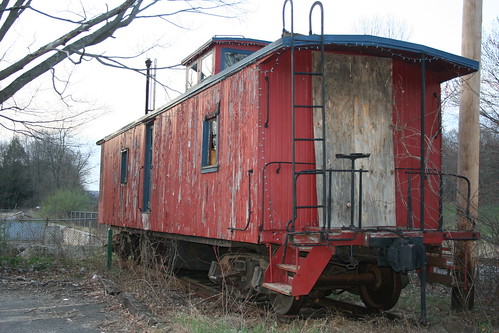
This past April, I was on a drive to capture some “backside” pictures when I passed a caboose along Route 44 in Mansfield, CT. I didn't know the area, but turned around on Brigham Tavern Rd. (That was for you, Dave.) I pulled into a lot with a deserted building to the left and the wooden, weather-beaten caboose to the right nestled next to some railroad tracks. Being low on time, I only snapped a few shots, but vowed to go back after I found some information on this old car.

I did go back in May to take more pictures, but was having trouble finding information about the old caboose. I found one article about a caboose that sat outside of the Mansfield Depot Restaurant, but not being from Connecticut, I didn't even know if this was the location of the restaurant. Also, there was no real description of the red wooden car with blue-framed windows, so I wasn't sure this was “my” caboose.
Well, I was surprised and delighted recently to see an article in the Hartford Courant about an old caboose being transported from Mansfield, CT, to the Connecticut Trolley Museum in East Windsor. As it turns out, it is “my” red, weather-beaten caboose. The article describes the wooden caboose with the table set with silverware and wine glasses like I remembered. The caboose was spared in a 2003 fire that destroyed the Mansfield Depot Restaurant. The caboose has sat basically untouched since the fire. I'm glad to hear it will be restored and utilized for special events. I'm also glad that this is one time that the backside has a happy ending.
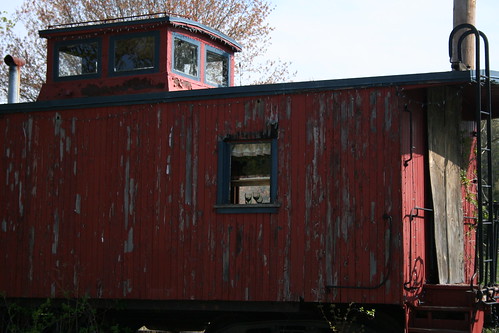

This past April, I was on a drive to capture some “backside” pictures when I passed a caboose along Route 44 in Mansfield, CT. I didn't know the area, but turned around on Brigham Tavern Rd. (That was for you, Dave.) I pulled into a lot with a deserted building to the left and the wooden, weather-beaten caboose to the right nestled next to some railroad tracks. Being low on time, I only snapped a few shots, but vowed to go back after I found some information on this old car.

I did go back in May to take more pictures, but was having trouble finding information about the old caboose. I found one article about a caboose that sat outside of the Mansfield Depot Restaurant, but not being from Connecticut, I didn't even know if this was the location of the restaurant. Also, there was no real description of the red wooden car with blue-framed windows, so I wasn't sure this was “my” caboose.
Well, I was surprised and delighted recently to see an article in the Hartford Courant about an old caboose being transported from Mansfield, CT, to the Connecticut Trolley Museum in East Windsor. As it turns out, it is “my” red, weather-beaten caboose. The article describes the wooden caboose with the table set with silverware and wine glasses like I remembered. The caboose was spared in a 2003 fire that destroyed the Mansfield Depot Restaurant. The caboose has sat basically untouched since the fire. I'm glad to hear it will be restored and utilized for special events. I'm also glad that this is one time that the backside has a happy ending.

Saturday, September 18, 2010
Pig Out

From Dave Brigham:
I ate at the Pig 'n Whistle in Brighton just once, and I have to say, the food wasn't memorable. I recall that it was on Patriot's Day, a Massachusetts-only holiday that also happens to be Boston Marathon day. I went to the race with my girlfriend (now wife), Beth, and my friend, Jeff. Afterwards, Jeff and I went to the diner, and strangely enough the only thing I remember eating was green beans, which I rarely eat. I believe there were mashed potatoes, too. The main course was probably steak or pot roast.
Despite this less-than-memorable meal, I love diners and was sorry to see this place close up a few years back. Web searches have turned up no useful information about why the place closed, or what the fate of the property might be. I did find something kind of cool, though: a "Zippy the Pinhead" cartoon from February 2001 featuring the diner.
I pass by the diner with some regularity, and have long wondered about the significance of the name. Turns out it's a popular name for British pubs (along with more colorful names such as The Dog and Duck, The Slug and Lettuce and The Goat and Compasses), but that the origin of the name is somewhat confusing. Take your pick:
1) Pig derives from drinking vessel names, i.e., peg, piggin or, most obviously, pig. Whistle might come from "wassail," a spiced ale.
Or
2) Servants were obliged to whistle when they went to the basement to get "pigs" for beer in order to prove that they weren't drinking the ale.
Or
3) Pigs and whistles might mean odds and ends.
Wednesday, September 15, 2010
Cool Your Jets!
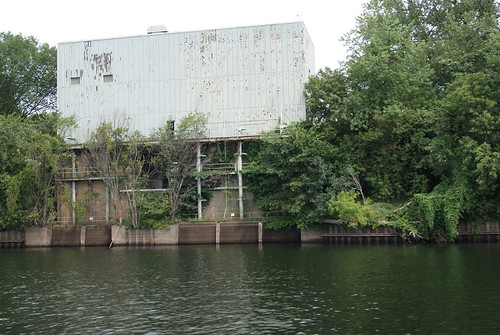
From Dave Brigham:
As I noted in the inaugural post for this site more than six months ago, rivers offer some of the best views of the backside of America (see Take Me to the River, 3-1-10). On a recent cruise down the Connecticut River on the Hartford Belle, I enjoyed seeing the wooded banks, the osprey nests and the boats. But I was more interested in the Wethersfield Cove warehouse, which is operated by the local historical society, and, especially, the hulking green slab you see above.
I asked the Belle's captain about it. He told me it was an old Pratt & Whitney jet engine testing facility. "They used to do things like toss dead birds into the engines to see how they held up," he said.
The facility's official name is the Pratt & Whitney Andrew Willgoos Turbine Laboratory. After a little research online, I found out that the lab was built in the late '40s, and that the with help of acoustical engineers, "none of the noisy operations inside the building [could] be heard at nearby residences," according to a 1952 report from the Acoustical Society of America.
I also found a real web gem (to steal an ESPN phrase): a copy of The Tech, , M.I.T.'s official newspaper, from 1956 that describes in -- surprise! -- very technical terms the kind of work done at the facility. Check out the file here; you'll have to scroll down a bit to find it.
As for the dock shown below, it seems as though supply boats tied up there to transfer oil to the facility. The lab also used an incredible volume of water from the Connecticut River to cool the engines and testing equipment, so it's possible that the wharf helped facilitate that process as well.
As usual with these places, there's no way to know what's next. I imagine taking this facility apart and cleaning it up will take millions upon millions of dollars, lots of time and effort and that it probably won't happen for a long, long time.
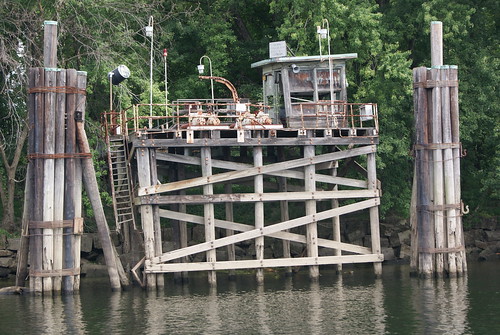
Sunday, September 12, 2010
Smokestack Lightnin'
From Mick Melvin:
On a trip to Pennsylvania to visit my family, I took a side trip to Delaware to visit my best friend. As I drove on Route 72, I noticed a lone smokestack in a vacant lot in Newark. It got me thinking of its origins. On my way back to PA, I took some shots of the structure and noticed the name Curtis embedded on the smokestack. When I returned home, I went to the Internet to investigate and was quite surprised to find plenty of info on this site.

The smokestack is the only structure left from The Curtis Paper Mill. The complex was purchased by the Curtis brothers in 1848, although a mill had existed on the site since the late eighteenth century. The mill was also known as the Nonantum Mill, which refers to the Indian name for an area in Newton, Mass., where the Curtis brothers grew up (an area known colloquially as The Lake, and which is about a five-minute walk from my house -- ed.).
The James River Corp. later purchased the plant, but the mill closed in 1997. The plant was eventually demolished in December 2007, leaving the smokestack as the lone reminder of years past. An effort is under way to save the stack from demolition.
On a trip to Pennsylvania to visit my family, I took a side trip to Delaware to visit my best friend. As I drove on Route 72, I noticed a lone smokestack in a vacant lot in Newark. It got me thinking of its origins. On my way back to PA, I took some shots of the structure and noticed the name Curtis embedded on the smokestack. When I returned home, I went to the Internet to investigate and was quite surprised to find plenty of info on this site.

The smokestack is the only structure left from The Curtis Paper Mill. The complex was purchased by the Curtis brothers in 1848, although a mill had existed on the site since the late eighteenth century. The mill was also known as the Nonantum Mill, which refers to the Indian name for an area in Newton, Mass., where the Curtis brothers grew up (an area known colloquially as The Lake, and which is about a five-minute walk from my house -- ed.).
The James River Corp. later purchased the plant, but the mill closed in 1997. The plant was eventually demolished in December 2007, leaving the smokestack as the lone reminder of years past. An effort is under way to save the stack from demolition.
Thursday, September 9, 2010
The Privilege Is All Mine

From Dave Brigham:
There's no shortage of scenes like this in the Greater Boston area: old stone walls and dilapidated fences keeping people out (although there are surely more sophisticated security devices as you get closer) of magnificent old-money properties, leaving everything to the imagination.
While I love looking at such architectural gems up close and personal, or in magazine spreads, I find it more interesting and exhilarating to put together a picture in my mind's eye based on peeks through the hedges, up the long driveways or through the surrounding woods. I imagine that everyone who lives in such places lives like the Gatsbys, strolling the grounds in linen suits and Lilly Pulitzer dresses, kids decked out in Polo wear, sipping gimlets and and planning how to maximize profits from their trust funds.
In this case, we're looking at the boundary of a property with ties to prominent WASP families including the Welds, Saltonstalls and Endicotts. But alas there are no penny loafer-wearing fops or Izod-sporting debutantes roaming the grounds. The house and grounds were donated to M.I.T. a half century ago for use as a conference and special event facility, known as the M.I.T. Endicott House, in Dedham, MA.
If you have business there, you can drive right up and check it out. Just don't tell me about it; I've got a better picture in my mind.
Monday, September 6, 2010
UPDATED: Horsing Around At the Old Barracks
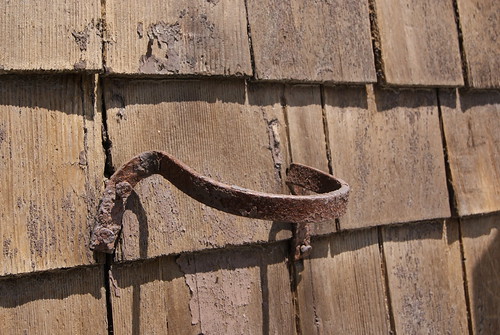
From Dave Brigham:
UPDATE: Well, better late than never, I found out what the deal is with these buildings. In my original online searches, I used terms the following search terms -- "brighton mass. state police barracks abandoned" -- and found absolutely nothing. Just goes to show you, that the Internet will tell you just about anything you want to know, but only if you know what you're looking for.
Here's my revised entry.
Thanks to a guy named Mike Rubino, Jr. opting to make the photos you see here "favorites" on Flickr, I checked out his Flickr page and discovered that the buildings on Western Ave. and Soldiers Field Road in Brighton, Mass., aren't former state police barracks, but rather something more interesting and colorful.
Mike, who runs the M.D.C. Police Photos web site, has a picture of one of these buildings on his Flickr page, under the title "Speedway Headquarters, Charles River Reservation." I read that and thought, "Huh, what the heck is the Speedway?"
A search turned up good information from both the Boston Public Library and Brighton Allston Historical Society web sites. From the BAHS site:
"One of the functions the Speedway served was to accommodate the recreational vehicles that had previously used the Brighton Road (the portion of Commonwealth Ave lying west of Kenmore Square) as well as Beacon St in Brookline for driving and racing horse drawn conveyances. As these roadways experienced increased development and automotive traffic in the early years of the century, the focus of such activity switched to the Charles River Speedway."
In other words, the powers that be saw that this race track was built in order to accommodate speed-crazy teenagers and their horse-drawn buggy races! If the History Channel made a show about this phenomenon, they'd have to call it, "Gone in 60 Minutes."
Anyway, the BAHS site continues:
"The Superintendent's Building was located at the intersection of Western Ave and Soldier's Field Rd. and is the only portion of the complex that still remains."
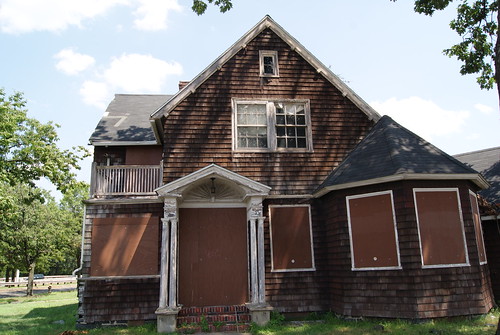
So that's what we're looking at here. The race course survived into the 1960s, amazingly enough. The superintendent's building and the other buildings were used until about 10 years ago, for use by the old Metropolitan District Commission and the Public Access Board.
The former race track area is now of mixed use, from parkland to office buildings and housing.
In my original post, when I thought that the buildings were former State Police barracks, I speculated that the state would eventually tear down the complex and a) build a proper facility for the State Police, who use an ugly brick building adjacent to this property, or, b) sell the land for retail, office or housing or, c) clear it for a park, which is what the site was originally.
Well, turns out that just three months ago, the Massachusetts Historical Commission filed a National Register of Historic Places registration form with the National Park Service, looking to preserve the buildings, and, presumably, restore them. That would be much more interesting than my original speculations about what might become of the site. Here's hoping the site makes it to the national register.
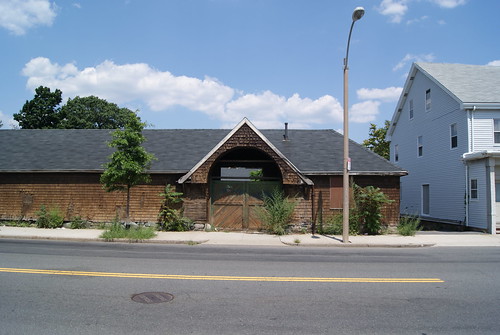
Monday, August 30, 2010
Going Underground
By Dave Brigham:
I've lived in the Boston area for 20 years, but I've learned more about the Hub of the Universe in the last two years than in the previous 18, thanks to a series of subterranean tours with my subway-loving son. He loves everything about the trolleys -- the screeching sounds they make going around curves, the different models, the types of doors, what the wheels look like, you name it -- while I thoroughly enjoy people-watching and exploring new parts of the city.
I've taken countless photos of trains, tunnels, stations, buskers, funny graffiti, interesting buildings we see when we venture above ground for lunch, etc. But I'm equally fascinated by stuff like this litter-filled stairway that used to take folks down into Park Street station, the oldest subway destination in America, as seen through a grate.
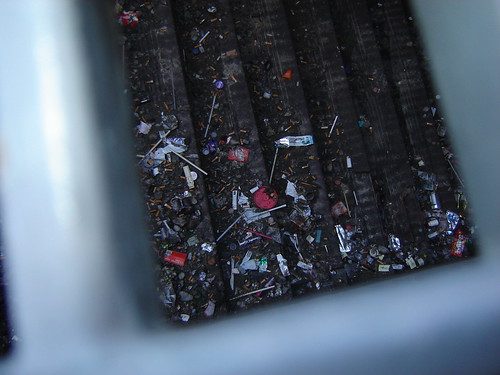
There's so much that doesn't meet the eye when traveling on the T (as the Boston subway system is known, short for MBTA). As you motor along between stations on the Green Line, you spy doors in the tunnel walls -- leading into the basements of certain buildings, so I've heard. There are doors in the stations that only T employees can access, and while most likely the only things back there are bathrooms, I want to see. I want to take a tour of the abandoned tunnels all around the city to learn how the different parts of Boston used to connect underground.
I can't do that, though, but others have. Check out Abandoned Subway Tunnels for some cool black-and-white pix, and this story and video from the Boston Globe.
Here's another photo shot through a grate, this one of a vent shaft near the Government Center T stop.
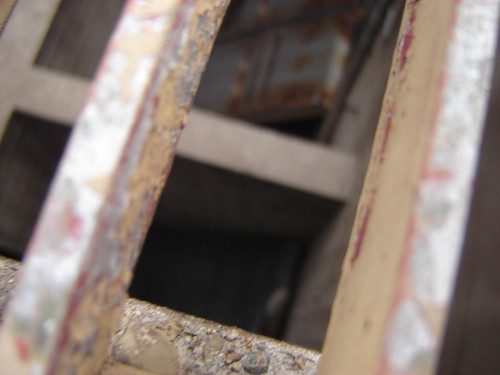
As much as I've come to enjoy my subway jaunts, I'm always well aware of how old and fragile so much of the system is. Many stations have been upgraded in recent years, and plenty are in the process of being renovated. Below is a shot of a concrete wall, at State Street station on the Blue Line, that has been scraped away, exposing rebar underneath.
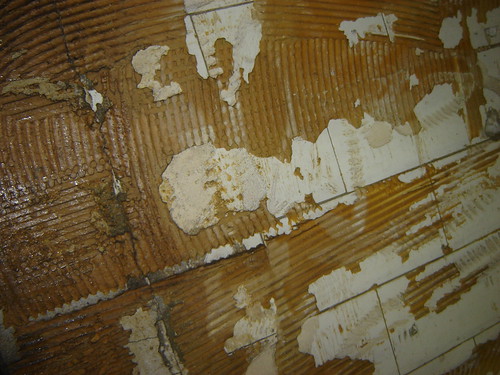
I look forward to many more years of exploring Boston and discovering the nooks and crannies that make the subway system special.
I've lived in the Boston area for 20 years, but I've learned more about the Hub of the Universe in the last two years than in the previous 18, thanks to a series of subterranean tours with my subway-loving son. He loves everything about the trolleys -- the screeching sounds they make going around curves, the different models, the types of doors, what the wheels look like, you name it -- while I thoroughly enjoy people-watching and exploring new parts of the city.
I've taken countless photos of trains, tunnels, stations, buskers, funny graffiti, interesting buildings we see when we venture above ground for lunch, etc. But I'm equally fascinated by stuff like this litter-filled stairway that used to take folks down into Park Street station, the oldest subway destination in America, as seen through a grate.

There's so much that doesn't meet the eye when traveling on the T (as the Boston subway system is known, short for MBTA). As you motor along between stations on the Green Line, you spy doors in the tunnel walls -- leading into the basements of certain buildings, so I've heard. There are doors in the stations that only T employees can access, and while most likely the only things back there are bathrooms, I want to see. I want to take a tour of the abandoned tunnels all around the city to learn how the different parts of Boston used to connect underground.
I can't do that, though, but others have. Check out Abandoned Subway Tunnels for some cool black-and-white pix, and this story and video from the Boston Globe.
Here's another photo shot through a grate, this one of a vent shaft near the Government Center T stop.

As much as I've come to enjoy my subway jaunts, I'm always well aware of how old and fragile so much of the system is. Many stations have been upgraded in recent years, and plenty are in the process of being renovated. Below is a shot of a concrete wall, at State Street station on the Blue Line, that has been scraped away, exposing rebar underneath.

I look forward to many more years of exploring Boston and discovering the nooks and crannies that make the subway system special.
Friday, August 27, 2010
Shuttered Island
From Dave Hill:
I took these pictures in April, 2010, on a sailing trip to Peddocks Island in Boston Harbor, when I decided to try out my new dinghy and outboard.
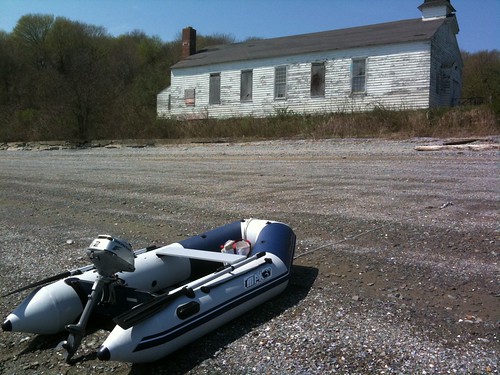
The photo above shows a chapel that was part of Fort Andrews, which was constructed beginning in 1904 and remained as an active military base until the end of World War II. During World War II, the island's base was used, in part, to house Italian prisoners of war. The chapel is probably one of the most prominent buildings visible on the island, and can be clearly seen across the channel from the tip of Hull.
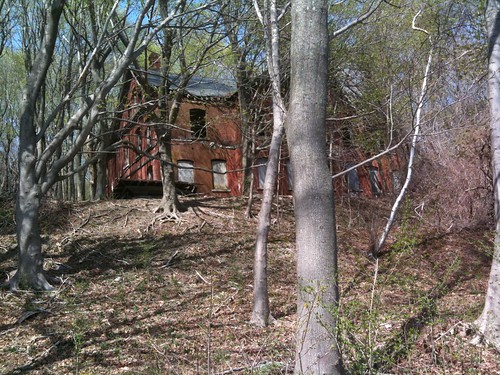
Above is one of the many run-down brick buildings on the island. This one was probably used as officers' housing, and is located along the path that runs south from the chapel along the eastern shore of the island. Had I been less worried about my dinghy floating away with the incoming tide, I would have ventured closer for better pix.
If you followed the path down the hill you'd eventually come to the small community of summer cottages that still exists on the island.
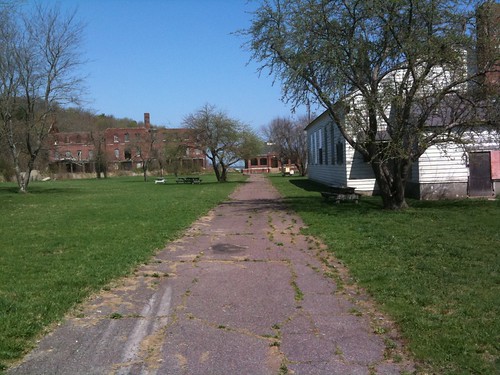
Looking north from just behind the chapel (the white building on the right), the buildings here are the main reception area for visitors who take one of the ferries to the islands today. The whole island, which was used as a setting for Martin Scorsese's "Shutter Island," is part of the Boston Harbor Islands park system. There is frequent ferry service to/from the island during the summer -- it is well worth a visit, in my opinion.
I took these pictures in April, 2010, on a sailing trip to Peddocks Island in Boston Harbor, when I decided to try out my new dinghy and outboard.

The photo above shows a chapel that was part of Fort Andrews, which was constructed beginning in 1904 and remained as an active military base until the end of World War II. During World War II, the island's base was used, in part, to house Italian prisoners of war. The chapel is probably one of the most prominent buildings visible on the island, and can be clearly seen across the channel from the tip of Hull.

Above is one of the many run-down brick buildings on the island. This one was probably used as officers' housing, and is located along the path that runs south from the chapel along the eastern shore of the island. Had I been less worried about my dinghy floating away with the incoming tide, I would have ventured closer for better pix.
If you followed the path down the hill you'd eventually come to the small community of summer cottages that still exists on the island.

Looking north from just behind the chapel (the white building on the right), the buildings here are the main reception area for visitors who take one of the ferries to the islands today. The whole island, which was used as a setting for Martin Scorsese's "Shutter Island," is part of the Boston Harbor Islands park system. There is frequent ferry service to/from the island during the summer -- it is well worth a visit, in my opinion.
Subscribe to:
Posts (Atom)
More Military Relics in the Home of the American Revolution
From Dave Brigham: My hour-long hike through the Annursnac-Baptist Brook Conservation Area would have been perfect, but for the distant wh...

-
From Dave Brigham: My hometown, Simsbury, Connecticut, is about 34 square miles in area, or almost twice as large as my adopted hometown o...
-
From Dave Brigham: During the time I've been wrestling with this post you could've written, cast, shot, edited, promoted, released...